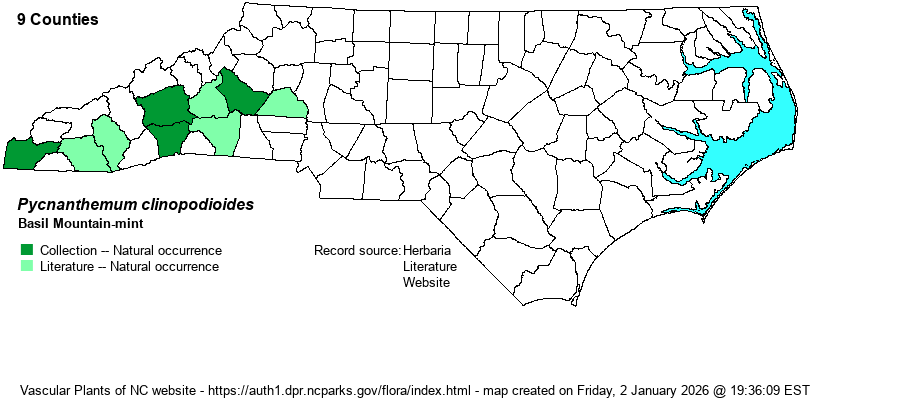| Author | Torrey & A. Gray | |
| Distribution | Weakley (2024) says that it is a Northern species, mainly in the Coastal Plain; and the Digital Atlas of Virginia Flora website shows scattered records across that state, even in the southeastern corner near NC. Yet, the few known NC specimens and sight reports are limited to the southern Mountains and the southwestern Piedmont. Thus, it should occur at least in the northern portions of the NC Piedmont and Coastal Plain. Obviously, this species -- "Probably an allotetraploid hybrid" (Weakley 2024) -- is very poorly known in the state. This appears to be included within P. verticillatum in RAB (1968) and most other references.
This species ranges from MA south to NC, according to Weakley (2018).
| |
| Abundance | The NCNHP has the species on its Watch List (W7), and gives it a State Rank of S1? The website editors feel that it is not super rare and suggest S2?, and that means the Global Rank should be moved to G2?, if not G3? It might best be called as "rare to locally uncommon" in the southwestern part of the state. It is very clear that few botanists are aware of this species, and most or nearly all would simply overlook it and not collect it. | |
| Habitat | "Dry, sandy or rocky woodlands, clearings, and rock outcrops" (Digital Atlas of Virginia Flora) are the habitats in VA. Habitats in NC are not well known or described. | |
| Phenology | Blooms from July to September, and fruits shortly after flowering. | |
| Identification | This species is a typical mountain-mint, being about 3 feet tall, freely branched in the upper portions of the stem, and with numerous pairs of opposite leaves. The stem of this species has hairs on both the edges and the sides. In this species, the leaves tend to be lanceolate, narrower than many species in the genus, about 1.5-2 inches long and about 8-12 mm (2/5-inch) wide, about 4-5 times longer than wide, and nearly sessile, barely toothed along the margin. These species have rather flat-topped heads of about 1-2 inches wide at the ends of each branch, subtended by bracts, with the flowers being very small and generally white with some purple spots on the lower lip. There are many such heads in bloom over the plant, often dozens of them. This species is separated from the very similar P. verticillatum and P. torreyi by detailed calyx characters, and thus a hand lens might be needed. You will need to check the key in Weakley (2018) for identification of this species. | |
| Taxonomic Comments | Only some references consider this as a valid species, though NatureServe does, and not even with a "Q" for Questionable taxonomy. As Weakley (2018) also does, this website does also. It has apparently been subsumed within P. verticillatum in many or most references.
| |
| Other Common Name(s) | None | |
| State Rank | S1? [S2?] | |
| Global Rank | G1G2 [G2?] | |
| State Status | W7 | |
| US Status | | |
| USACE-agcp | | |
| USACE-emp | | |

